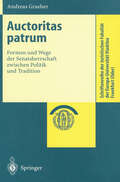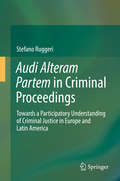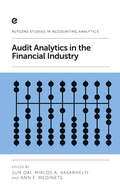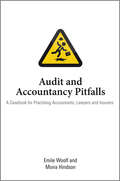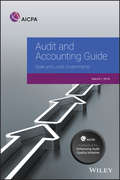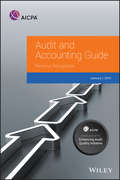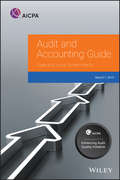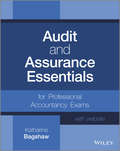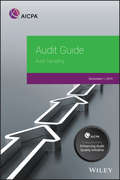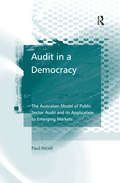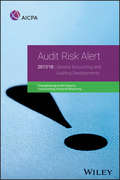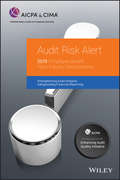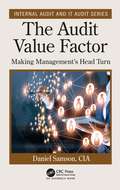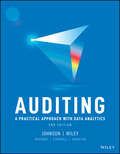- Table View
- List View
Auctoritas patrum: Formen und Wege der Senatsherrschaft zwischen Politik und Tradition (Schriftenreihe der Juristischen Fakultät der Europa-Universität Viadrina Frankfurt (Oder))
by Andreas GraeberAudi Alteram Partem in Criminal Proceedings: Towards a Participatory Understanding of Criminal Justice in Europe and Latin America
by Stefano RuggeriThis book analyses current developments in Europe and Latin America towards the greater involvement of the parties in the administration of criminal justice. Focusing on both national criminal proceedings and transnational cases, this study employs a comparative law approach to examine the shift experienced by Italy and Brazil from the long tradition of mixed criminal justice to unprecedented adversarial trends. The identification of common needs and divergences from the national approach to criminal justice paves the way for a subsequent analysis of new solution models emerging from international human rights law and EU law. To a great extent, these developments are due to the increasing impact of international human rights case-law on the criminal justice systems of the countries in question. The book concludes by proposing a set of qualitative requirements for a participatory model of criminal justice.
Audit Analytics in the Financial Industry (Rutgers Studies in Accounting Analytics)
by Jun Dai Miklos A. Vasarhelyi Ann F. MedinetsIn Audit Analytics in the Financial Industry, editors Jun Dai, Miklos A. Vasarhelyi and Ann F. Medinets bring together a cast of expert contributors to explore ways to integrate Audit Analytics techniques into existing audit programs for the financial industry. Separated into six parts, the contributors take a variety of approaches to this exploration. In Part One, the contributors present two articles illustrating the process of applying Audit Analytics to solving audit problems. Part Two contains four studies that use various Audit Analytics techniques to discover fraud risks and potential frauds in the credit card sector. In Part Three, the chapter focus on the insurance sector and show the application of clustering techniques in auditing. Part Four includes two chapters on how to employ Audit Analytics in the transitory system for fraud/anomaly detection. Finally, Parts Five and Six illustrate the use of Audit Analytics to assess risk in the lawsuit and payment processes. For students, researchers, and professionals in the accounting sector, this is an unmissable read exploring the latest research in Audit Analytics.
Audit Analytics in the Financial Industry (Rutgers Studies in Accounting Analytics)
by Jun Dai Miklos A. Vasarhelyi Ann F. MedinetsIn Audit Analytics in the Financial Industry, editors Jun Dai, Miklos A. Vasarhelyi and Ann F. Medinets bring together a cast of expert contributors to explore ways to integrate Audit Analytics techniques into existing audit programs for the financial industry. Separated into six parts, the contributors take a variety of approaches to this exploration. In Part One, the contributors present two articles illustrating the process of applying Audit Analytics to solving audit problems. Part Two contains four studies that use various Audit Analytics techniques to discover fraud risks and potential frauds in the credit card sector. In Part Three, the chapter focus on the insurance sector and show the application of clustering techniques in auditing. Part Four includes two chapters on how to employ Audit Analytics in the transitory system for fraud/anomaly detection. Finally, Parts Five and Six illustrate the use of Audit Analytics to assess risk in the lawsuit and payment processes. For students, researchers, and professionals in the accounting sector, this is an unmissable read exploring the latest research in Audit Analytics.
Audit and Accountancy Pitfalls: A Casebook for Practising Accountants, Lawyers and Insurers
by Emile Woolf Moira HindsonAvoiding Audit Pitfalls offers real case studies covering a comprehensive range of challenges and mistakes that any accountant can make during the course of their career. Focusing on everyday mistakes and failures common to auditors in all territories worldwide, the book will cover audit failures that have led to fraud going undetected as well as failure to accurately assess a firm's ability to continue. This book will appeal not only to general accountants and auditors but also to forensic accountant, and students in the field.
Audit and Accountancy Pitfalls: A Casebook for Practising Accountants, Lawyers and Insurers
by Emile Woolf Moira HindsonAvoiding Audit Pitfalls offers real case studies covering a comprehensive range of challenges and mistakes that any accountant can make during the course of their career. Focusing on everyday mistakes and failures common to auditors in all territories worldwide, the book will cover audit failures that have led to fraud going undetected as well as failure to accurately assess a firm's ability to continue. This book will appeal not only to general accountants and auditors but also to forensic accountant, and students in the field.
Audit and Accounting Guide: State and Local Governments 2018 (AICPA Audit and Accounting Guide)
by AICPAWith all the recent changes in state and local government audit and accounting, including changes to some of the more complex areas such as pensions and post-employment benefits other than pensions (OPEB), accountants and financial managers can't afford to be without the most current guidance. This authoritative guide provides complete coverage of audit and accounting considerations critical for both preparers and auditors. This edition includes two new schedules: Governmental Employer Participation in Single-Employer Plans: Illustrative Schedule of Pension Amounts and Report; and, Illustrative Notes to Schedule of Employer Allocations and Schedule of Pension Amounts. It also provides insights, comparisons, and best practices for financial reporting and the financial reporting entity, revenue and expense recognition, capital asset accounting, the elements of net position, accounting for fair value, municipal securities offerings, tax abatements and much more.
Audit and Accounting Guide: Revenue Recognition 2019 (AICPA Audit and Accounting Guide)
by AICPAASC 606, Revenue from Contracts with Customers, replaces almost all previously existing revenue recognition guidance, including industry-specific guidance. That means unprecedented changes, affecting virtually all industries and all size organizations. For preparers, this guide provides the comprehensive, reliable accounting implementation guidance you need to unravel the complexities of this new standard. For practitioners, it provides in-depth coverage of audit considerations, including controls, fraud, risk assessment, and planning and execution of the audit. Recent audit challenges are spotlighted to allow for planning in avoiding these new areas of concern. This guide includes 16 industry-specific chapters for the following industries: Aerospace and Defense, Airlines, Asset Management, Broker-Dealers, Construction Contractors, Depository Institutions, Gaming, Health Care, Hospitality, Insurance, Not-for-Profits, Oil and Gas, Power and Utility, Software, Telecommunications, and Timeshare.
Audit and Accounting Guide: State and Local Governments 2019 (AICPA Audit and Accounting Guide)
by AicpaState and local government audit and accounting is changing rapidly. This title features insights, comparisons, and best practices for some of the more complex areas such as pensions and post-employment benefits other than pensions (OPEB), this authoritative guide provides complete coverage of audit and accounting considerations critical for both preparers and auditors. This edition includes dual guidance for accountants and auditors early implementing GASB Statement No. 84, Fiduciary Activities. Topics covered also include: • Financial reporting and the financial reporting entity • Revenue and expense recognition • Capital asset accounting • The elements of net position • Accounting for fair value • Municipal securities offerings • Tax abatements
Audit and Accounting Guide: Revenue Recognition 2019 (AICPA Audit and Accounting Guide)
by AICPAASC 606, Revenue from Contracts with Customers, replaces almost all previously existing revenue recognition guidance, including industry-specific guidance. That means unprecedented changes, affecting virtually all industries and all size organizations. For preparers, this guide provides the comprehensive, reliable accounting implementation guidance you need to unravel the complexities of this new standard. For practitioners, it provides in-depth coverage of audit considerations, including controls, fraud, risk assessment, and planning and execution of the audit. Recent audit challenges are spotlighted to allow for planning in avoiding these new areas of concern. This guide includes 16 industry-specific chapters for the following industries: Aerospace and Defense, Airlines, Asset Management, Broker-Dealers, Construction Contractors, Depository Institutions, Gaming, Health Care, Hospitality, Insurance, Not-for-Profits, Oil and Gas, Power and Utility, Software, Telecommunications, and Timeshare.
Audit and Accounting Guide: State and Local Governments 2019 (AICPA Audit and Accounting Guide)
by AicpaState and local government audit and accounting is changing rapidly. This title features insights, comparisons, and best practices for some of the more complex areas such as pensions and post-employment benefits other than pensions (OPEB), this authoritative guide provides complete coverage of audit and accounting considerations critical for both preparers and auditors. This edition includes dual guidance for accountants and auditors early implementing GASB Statement No. 84, Fiduciary Activities. Topics covered also include: • Financial reporting and the financial reporting entity • Revenue and expense recognition • Capital asset accounting • The elements of net position • Accounting for fair value • Municipal securities offerings • Tax abatements
Audit and Assurance Essentials: For Professional Accountancy Exams
by Katharine BagshawAn accessible beginner’s guide to the fundamentals of audit and assurance Audit and assurance is a basic and vital aspect of the financial world and a key element of all professional accountancy programs. Whereas professional training on the topic frequently immerses students in too much detail while glossing the basics, this book begins with the fundamentals and expands to cover the details in a more measured way. With practical examples and end-of-chapter examples, External Audit and Assurance Essentials breaks down a difficult and challenging field of professional accounting.
Audit and Assurance Essentials: For Professional Accountancy Exams
by Katharine BagshawAn accessible beginner’s guide to the fundamentals of audit and assurance Audit and assurance is a basic and vital aspect of the financial world and a key element of all professional accountancy programs. Whereas professional training on the topic frequently immerses students in too much detail while glossing the basics, this book begins with the fundamentals and expands to cover the details in a more measured way. With practical examples and end-of-chapter examples, External Audit and Assurance Essentials breaks down a difficult and challenging field of professional accounting.
Audit Guide: Government Auditing Standards And Single Audits 2017 (AICPA Audit Guide)
by AICPAUpdated as of December 1, 2019, this guide continues to be an indispensable resource packed with information on sampling requirements and methods. It introduces statistical and nonstatistical sampling approaches, and features case studies illustrating the use of different sampling methods, including classical variables sampling and monetary unit sampling, in real-world situations.
Audit Guide: Sampling 2019 (AICPA Audit Guide)
by AICPAUpdated as of December 1, 2019, this guide continues to be an indispensable resource packed with information on sampling requirements and methods. It introduces statistical and nonstatistical sampling approaches, and features case studies illustrating the use of different sampling methods, including classical variables sampling and monetary unit sampling, in real-world situations.
Audit in a Democracy: The Australian Model of Public Sector Audit and its Application to Emerging Markets
by Paul NicollExploring the role of public sector audit in emerging democracies and developing countries, this book provides an account of the relationship between the public sector auditor, the legislature and executive government. In particular, it introduces public sector audit's capacity to assess government agencies' compliance with the law and their management of taxpayer or internationally funded programs and services. The volume: ¢ Explores the Australian model of public sector audit. ¢ Provides a definition of a supreme Audit Institution (SAI) and the role and responsibilities of the public sector auditor. ¢ Examines the authority necessary for the SAI to function effectively. ¢ Discusses likely future reform of the SAI's legal framework. ¢ Illustrates how audit can be used to strengthen democratic institutions in emerging market economies. It will be of use to researchers, academics and students interested in the critical issues surrounding audit in general and public sector audit in particular. It will also be a valuable guide to practitioners in this area.
Audit in a Democracy: The Australian Model of Public Sector Audit and its Application to Emerging Markets
by Paul NicollExploring the role of public sector audit in emerging democracies and developing countries, this book provides an account of the relationship between the public sector auditor, the legislature and executive government. In particular, it introduces public sector audit's capacity to assess government agencies' compliance with the law and their management of taxpayer or internationally funded programs and services. The volume: ¢ Explores the Australian model of public sector audit. ¢ Provides a definition of a supreme Audit Institution (SAI) and the role and responsibilities of the public sector auditor. ¢ Examines the authority necessary for the SAI to function effectively. ¢ Discusses likely future reform of the SAI's legal framework. ¢ Illustrates how audit can be used to strengthen democratic institutions in emerging market economies. It will be of use to researchers, academics and students interested in the critical issues surrounding audit in general and public sector audit in particular. It will also be a valuable guide to practitioners in this area.
Audit Risk Alert: General Accounting and Auditing Developments, 2017/18 (AICPA)
by AICPAUpdated annually, this useful resource contains a description of all recent auditing, accounting and regulatory developments to ensure that the accountant has a robust understanding of the business, economic, and regulatory environments in which they and their clients operate. In addition, this alert ensures that the accountant has a full understanding of emerging practice issues, with targeted analysis of new developments and how they may affect your engagements, including: • Recent Economic Trends • Recent Legislative and PCAOB Developments • Developments in Peer Review • Recent Ethics Interpretations It also contains new accounting and auditing guidance related to derivatives and hedging, service concession agreements, discontinued operations, stock compensation, and more
Audit Risk Alert: Employee Benefit Plans Industry Developments, 2019 (AICPA)
by AICPAThe increasing complexity of employee benefit plan auditing and focus by the Department of Labor have resulted in significant pressure for CPAs and firms performing EBP audits. To help CPAs meet the challenge of performing quality audits in this unique and complex area, the AICPA has developed this alert to assist in identifying current sources of risk within EBP audit engagements. Written by a task force consisting of current and former employee benefit plan expert panel members, this alert features discussions on new developments and issues that auditors may face in their current audits, as well as a look at what's in the pipeline that may affect your engagements. Updates in 2019: FASB ASU No. 2017-06, Employee Benefit Plan Master Trust Reporting FASB ASU No. 2018-09, Codification Improvements FASB ASU No. 2018-13, Fair Value Measurement (Topic 820), Disclosure Framework–Changes to the Disclosure Requirements for Fair Value Measurement
Audit Risk Alert: Employee Benefit Plans Industry Developments, 2019 (AICPA)
by AICPAThe increasing complexity of employee benefit plan auditing and focus by the Department of Labor have resulted in significant pressure for CPAs and firms performing EBP audits. To help CPAs meet the challenge of performing quality audits in this unique and complex area, the AICPA has developed this alert to assist in identifying current sources of risk within EBP audit engagements. Written by a task force consisting of current and former employee benefit plan expert panel members, this alert features discussions on new developments and issues that auditors may face in their current audits, as well as a look at what's in the pipeline that may affect your engagements. Updates in 2019: FASB ASU No. 2017-06, Employee Benefit Plan Master Trust Reporting FASB ASU No. 2018-09, Codification Improvements FASB ASU No. 2018-13, Fair Value Measurement (Topic 820), Disclosure Framework–Changes to the Disclosure Requirements for Fair Value Measurement
Audit Risk Alert: General Accounting and Auditing Developments, 2017/18 (AICPA)
by AICPAUpdated annually, this useful resource contains a description of all recent auditing, accounting and regulatory developments to ensure that the accountant has a robust understanding of the business, economic, and regulatory environments in which they and their clients operate. In addition, this alert ensures that the accountant has a full understanding of emerging practice issues, with targeted analysis of new developments and how they may affect your engagements, including: • Recent Economic Trends • Recent Legislative and PCAOB Developments • Developments in Peer Review • Recent Ethics Interpretations It also contains new accounting and auditing guidance related to derivatives and hedging, service concession agreements, discontinued operations, stock compensation, and more
The Audit Value Factor (Internal Audit and IT Audit)
by Daniel SamsonThe Audit Value Factor: Making Management’s Head Turn empowers readers with a systematic method to build and maintain a value-centric internal audit organization. The book explores how to identify, quantify, and articulate value for customers. It details six critical success factors: Value propositions that link directly to customer needs Fostering customer relationships using the CREATE model Talent development using the TEAM model Risk expertise that raises awareness, understanding, and action Change management and process optimization using the SMART model Data analytics that provide powerful insights to operations The Audit Value Factor offers easy to use tools and practical strategies that deliver tangible and immediate benefits for the internal audit team. Praise for The Audit Value Factor: Making Management’s Head Turn "Daniel Samson, the inspiring and forward-thinking CAE at SRI International, has created an essential guide to adding value through Internal Audit in his new book The Audit Value Factor. It's an important addition to any internal auditor's toolkit, with helpful suggestions on topics ranging from talent planning to data analytics. I highly recommend it to any internal audit professional looking to "up their game." Laurie A. Hanover, CIA, CAE Sunrun Inc. "Internal Auditors often strive for a ‘seat at the table,’ be it with Business Leaders, Senior Management, the Board, or really, any significant decision maker in an organization. In The Audit Value Factor, Dan Samson provides the roadmap to ensuring that Internal Audit gets not only that seat at the table, but also that role of a critical business partner that is valued in facilitating change and helping an organization achieve its goals." Brian Tremblay, CAE Acacia Communications "Great audit functions generate value and build leadership capacity from staff to CAE. The Audit Value Factor’s compelling examples, data, and actionable tools enable auditors at every level to build relationships of trust, ask the right questions, and deliver powerful insights to their organization." Dr. Kathryn Bingham, Executive Coach and CEO, LEADistics LLC
The Audit Value Factor (Internal Audit and IT Audit)
by Daniel SamsonThe Audit Value Factor: Making Management’s Head Turn empowers readers with a systematic method to build and maintain a value-centric internal audit organization. The book explores how to identify, quantify, and articulate value for customers. It details six critical success factors: Value propositions that link directly to customer needs Fostering customer relationships using the CREATE model Talent development using the TEAM model Risk expertise that raises awareness, understanding, and action Change management and process optimization using the SMART model Data analytics that provide powerful insights to operations The Audit Value Factor offers easy to use tools and practical strategies that deliver tangible and immediate benefits for the internal audit team. Praise for The Audit Value Factor: Making Management’s Head Turn "Daniel Samson, the inspiring and forward-thinking CAE at SRI International, has created an essential guide to adding value through Internal Audit in his new book The Audit Value Factor. It's an important addition to any internal auditor's toolkit, with helpful suggestions on topics ranging from talent planning to data analytics. I highly recommend it to any internal audit professional looking to "up their game." Laurie A. Hanover, CIA, CAE Sunrun Inc. "Internal Auditors often strive for a ‘seat at the table,’ be it with Business Leaders, Senior Management, the Board, or really, any significant decision maker in an organization. In The Audit Value Factor, Dan Samson provides the roadmap to ensuring that Internal Audit gets not only that seat at the table, but also that role of a critical business partner that is valued in facilitating change and helping an organization achieve its goals." Brian Tremblay, CAE Acacia Communications "Great audit functions generate value and build leadership capacity from staff to CAE. The Audit Value Factor’s compelling examples, data, and actionable tools enable auditors at every level to build relationships of trust, ask the right questions, and deliver powerful insights to their organization." Dr. Kathryn Bingham, Executive Coach and CEO, LEADistics LLC
